Page - Results
Improving Reading, Concentration and GCSE Examination Results
by Alan Heath, BSc. (Hons.) Psych.
The Movement Program is a sequence of progressive movements over a 12 week period. Initially developed in collaboration between Leigh Academies Trust, Learning Solutions in the UK, and Advanced Brain Technologies, it has been shown to significantly improve reading age, academic performance, and English exam results, as well as balance, coordination and the inhibition of primitive reflexes.
Overview
In the UK, as with other countries, reading at Primary age level and access to the curriculum with strong literacy skills at Secondary age level is vital. The UK Government Department for Education statistics1 show that 15% of children leave Primary School at age 11 without the necessary reading skills to succeed. These results remain largely unchanged from previous years. 6% of these pupils have a reading age at least 4 years below their chronological age. Any program that can improve progress in reading should therefore be an important part of the school day.
In the recent OECD report2, the UK is among the bottom three countries when comparing literacy proficiency among 16-24-year-olds. Also, adults across the world who had poor levels of literacy as children, find that their skills remain weak or even deteriorate over time. The importance of developing strong literacy skills whilst in full time education cannot be overstated. Strong reading skills are based on an ability to understand rhythm and process auditory and visual information at the speed it is received by the brain.
At The Leigh Academy the challenge was particularly acute. Due to the large number of selective grammar schools in Kent, reading levels on entry to Year 7 were low. On average, 60% of students in 2003 had a reading age below their chronological age. Of these, 34% had a reading age at least 2 years below their chronological age.
60%
of students had a reading age below their chronological age
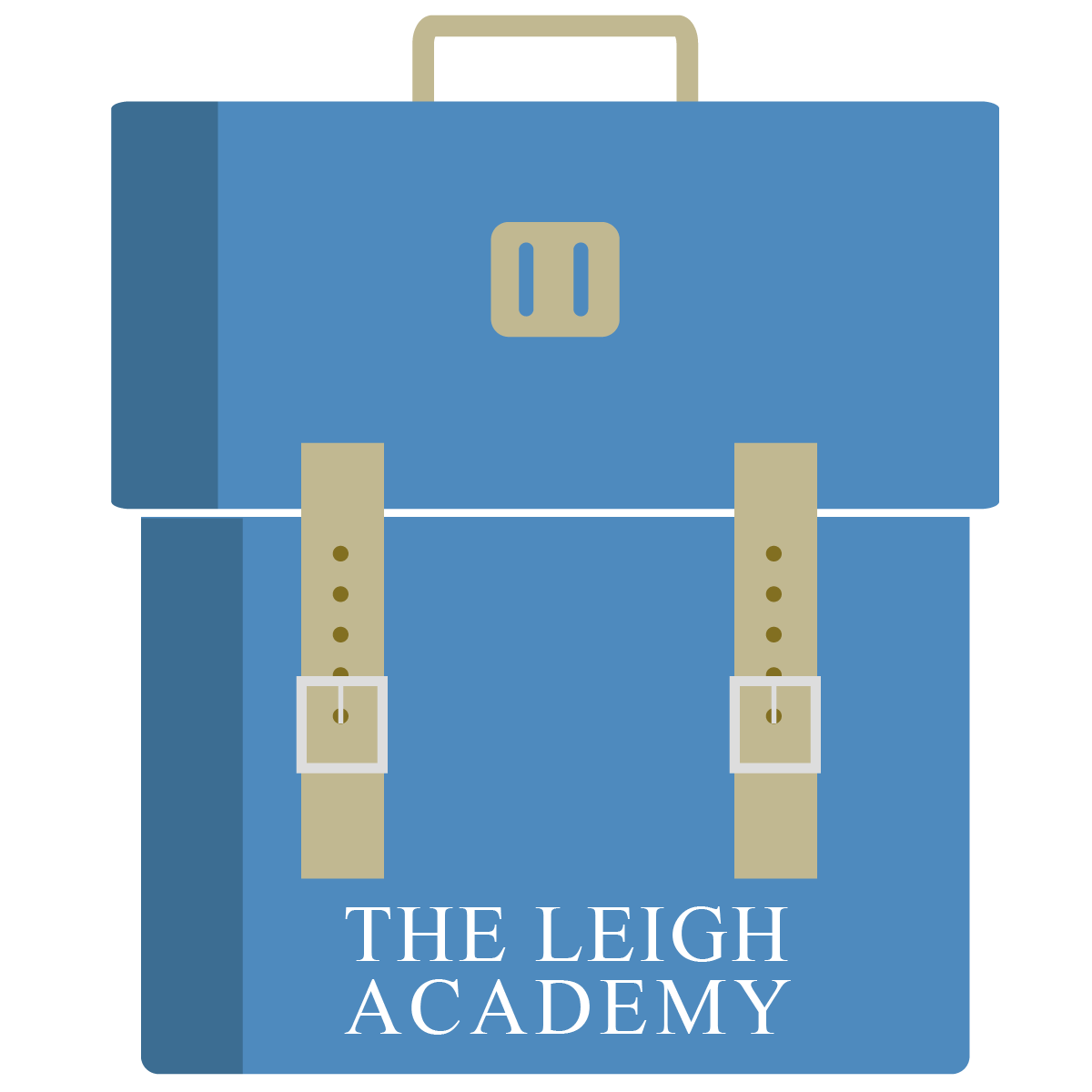
34%
had a reading age at least 2 years below their chronological age
Leigh set up an innovative Sensory Development Centre to find and develop interventions that could be used on large groups of students simultaneously. Over the period 2004 – 2013 they systematically tested and refined programmes to improve literacy levels. The Movement Program is the result of this longitudinal study.
Introduction
There has been interest for many years about the impact of movement and rhythm on reading and progress in learning. In 1966, Sterritt and Rudnick3 stated that “rhythm perception … is related to reading in fourth-grade boys in a way that is not fully accounted for by intelligence.”
More recently, a number of studies have closely linked reading problems with motor difficulties. Iverson et al (2005)4 found that the majority of a group of poor readers aged 10 – 12 as well as a group of students assessed with dyslexia had motor problems that would require intervention. Even in the control group which took a group of the top readers, 14% had significant motor problems. This type of research shows the validity of a movement and rhythm based program being used in schools for all pupils of this age.
Much of the available research naturally focuses upon specific labels such as dyslexia, DCD and ADHD, as well as emotional and behavioral difficulties. This area of research shows that all these labels have a motor component that should be addressed.
Just as there is very good evidence supporting the use of movement to gain progress in reading, the importance of rhythm and beat competency is also clear.
Tierney and Kraus5 showed that children who are unable to keep the rhythm by tapping to an external beat tend to be poorer readers and have reduced attention levels. Whilst being able to tap to an external beat may seem a simple task, it requires strong levels of auditory attention as well as timing. Many of these same skills are needed to develop strong reading, listening and attention. This supported earlier work by Thomson and Goswami6. Here it was shown that “rhythmic timing cues were strongly predictive of language, phonology, reading and spelling.”
An ability to match an external rhythm is important because it is a measure of how well our brain is able to process temporal patterns. These are a crucial part of language, listening and reading. Put simply, the better our rhythmic awareness, the better our reading ability, attention and listening skills. Clearly this is a fundamental skill that is necessary for academic success and daily life skills. Children who have not developed these skills to a high level are at risk of behavioral and emotional problems as well as reduced academic ability.
Research7 has also been conducted monitoring the way that sound is processed in the brainstem. This is below our conscious awareness and yet is crucial to how well higher parts of the brain receive an auditory signal. Three groups were used, ‘good’ readers, ‘average’ readers and ‘poor’ readers. There were clear differences in how well the brainstem represented changes in sound known as formant transitions in the three groups. The “poor readers had more variable brainstem responses to speech than did good readers.” This was evident in changes from the consonant to the vowel sound in language. You can imagine the impact upon listening and reading skills if it is difficult at times to differentiate between ‘bad’ and ‘Dad’ or ‘cat’ and ‘sat.’
These differences in processing are not down to fatigue over time but seem to be due to the delayed responses and variability in processing that can be evident in poor readers.
This type of evidence shows the links between differences in fundamental auditory processing abilities and reading. The auditory brainstem responses discussed above are dependent upon good synchronicity in the brain and the simultaneous firing of neurons. The fact that this is not well trained in poor readers will not only affect reading ability but also directed attention and other skills such as listening in background noise. Good readers have a stable representation of sound in the brain; poor readers do not.
The Movement Program was developed to train rhythmic skills for reading and literacy development as well as enhance motor function and other important developmental processes.
Longitudinal Study Leigh Academy Trust
The longitudinal research project conducted at The Leigh Academy began in 2004. Based in Kent, with a high level of selective Grammar Schools, the reading levels of pupils entering the Academy at age 11 (Year 7) was low. To tackle this inadequate level of literacy, an intervention was required that could be offered to all pupils with a minimum number of staff in a cost effective manner.
The Sensory Development Centre was established to assess innovative sound and movement programs to develop the fundamental skills required for literacy and academic success.
In 2004, all 225 pupils were tested using a range of standard literacy tests on entry into Year 7. They were also tested for balance and coordination skills, retained primitive reflexes, auditory processing and numeracy skills. The lowest ranked 100 readers were randomly placed into 4 groups. The 4 groups comprised three different sensory interventions and one control group of students. Pupils were tested again immediately following the 12-week intervention and also after 6 months.
Results
A full statistical analysis was conducted and it was very evident that The Movement Program had a significant impact upon reading by comparison with the control group who had received no intervention.
Figure 1
Reading results following implementation of The Movement Program.
(Weschler Objective Reading Dimensions (WORD) Basic words)
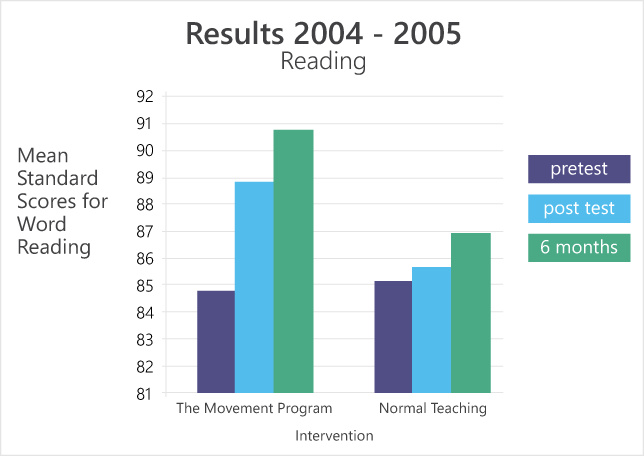
Reading levels in The Movement Program (TMP) group rose significantly* over the 6-month period compared to the control group who had no intervention.
*Statistical analysis not yet published by Leigh Academy Trust shows p=0.008, a highly significant gain in the TMP group.
Figure 2
The retention of primitive reflexes following implementation of The Movement Program.
(Primary Reflex Retention Assessment – McPhillips)
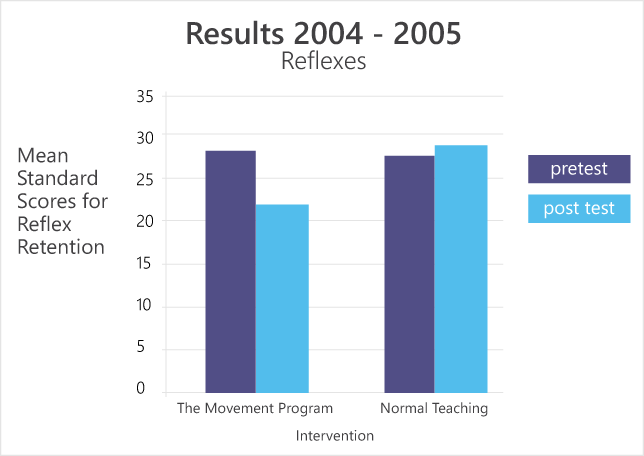
A statistically significant reduction (p=0.041) can be seen in the retention of primitive reflexes.
Figure 3
Balance and coordination improvements following The Movement Program.
(Balance and Coordination Assessment – McPhillips)
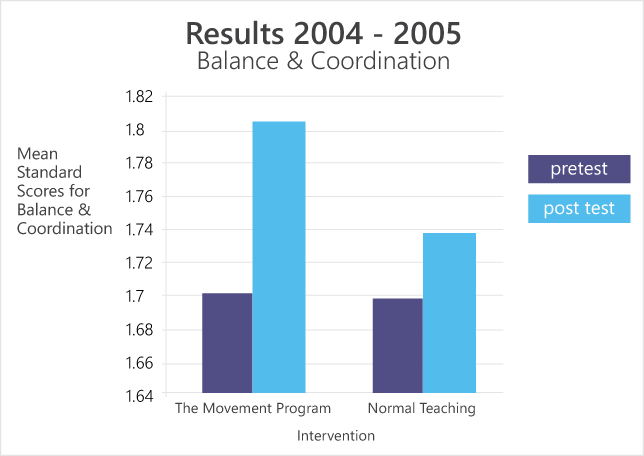
Significant improvements in balance and coordination (p=.041) were also seen when comparing the TMP group to the control group.
Improvements in such areas as balance and coordination and a reduction in the retention of primitive reflexes are understood to be an important factor in strong reading and attention skills. Comments from Frank Green, CBE who was CEO of Leigh Academy Trust at the time, (Schools Commissioner for England, 2014-16) confirmed that there was also a noticeable change in the day to day environment within school in that it was calmer with an improved focus on learning.
Following these strong initial results Leigh Academy were interested to see if this relatively short intervention in Year 7 would have a long-term impact upon GCSE examination results. In theory, improving basic sensory skills should improve academic performance. Using the Fisher Family Trust predictions from Year 6 they were able to compare the results of TMP and control groups as well as the 125 ‘good readers’ group who were not initially involved and had received no intervention.
Between the implementation of the 12-week program in Year 7 and the Year 11 GCSE exam results no other intervention was used, all students were within the same school environment and received the same teaching.
The graph below shows the significant improvements gained by the group who followed The Movement Program in Year 7.
Figure 4
English Language GCSE results in Year 11 compared to FFT predictions. (p=0.013)
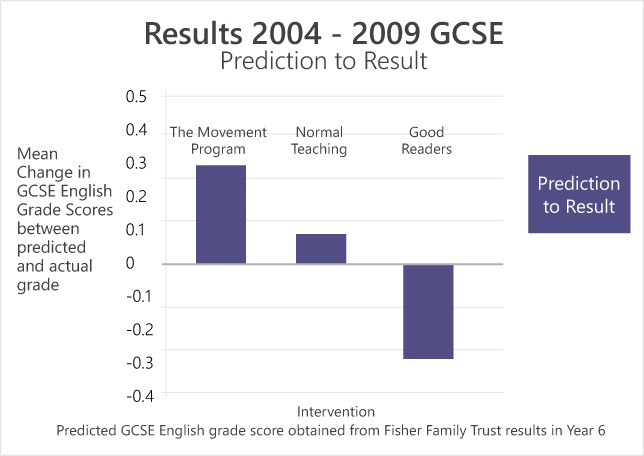
The students who followed the 12 week TMP program in Year 7 gained significantly stronger GCSE English results compared to the 150 pupils in the normal teaching and good readers groups.
Conclusion
Reading is a skill that needs practice. However, many students have not developed the basic sensory processing, timing and attention levels to be able to decode words, scan the page to read or be able to concentrate. The Movement Program offers a unique way to help develop the underpinning skills for reading and attention that cannot be achieved by simply undertaking extra reading. This not only impacts upon reading and attention, but can lead to wide ranging improvements in timing and rhythm for movement, sports and other areas of daily life.
References
1 Department for Education, Statistical First Release, September 2012. National Curriculum Assessments at Key Stage 2 in England (provisional)
2 OECD (2013), OECD Skills Outlook 2013: First Results from the Survey of Adult Skills, OECD Publishing. http://dx.doi.org/10.1787/9789264204256-en
3 Sterritt, G.M., and Rudnick, M. (1966) Auditory and visual rhythm perception in relation to reading ability in fourth-grade boys. Perceptual and Motor Skills. Vol. 22. pp 859-64
4 Iverson, S., Berg, K., Ellertsen, B., and Tonnessen, F. (2005) Motor Coordination Difficulties in a Municipality Group and in a Clinical Sample of Poor Readers. Dyslexia Vol.11 pp 217-231.
5 Tierney. A, T., and Kraus, N. (2013) The ability to tap to a beat relates to cognitive, linguistic and perceptual skills. Brain and Language. Vol. 124 pp 225-231.
6 Thomson, J. M. and Goswami, U. (2008) Rhythmic processing in children with developmental dyslexia: Auditory and motor rhythms link to reading and spelling. Journal of Physiology – Paris Vol. 102 pp 120-129
7 Hornickel, J. and Kraus, N., (2013) Unstable Representation of Sound: A Biological Marker of Dyslexia. The Journal of Neuroscience Vol. 33(8): pp 3500-3504